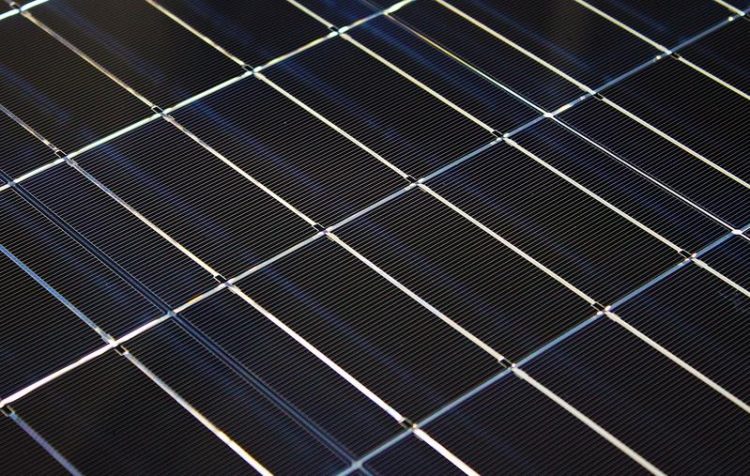ISFH achieves 20.2% record module efficiency for large-area PV modules with PERC solar cells

Close-up of the high-efficient PV module. The bright stripes between and on top of the cells arise from light reflection by the high-reflective cell interconnectors and the space between solar cells. ISFH
The Institute for Solar Energy Research Hamelin (ISFH), an affiliated institute of the “Leibniz Universität Hannover”, increases the module efficiency for large-area solar modules with industrial silicon-based PERC solar cells to a record value of 20.2% with a power of 303.2W, which was confirmed in an independent measurement by the TÜV Rheinland.
Thereby, the ISFH surpasses the former module record efficiency of 19.5% for industrial-type modules with p-type silicon solar cells and screen-printed metallization.
The results were achieved within the project “Prozessplattform und Verlustanalyse für klimastabile hocheffiziente Photovoltaikmodule mit kristallinen PERC-Si-Solarzellen” (PERC-2-Module) funded by the German Federal Ministry for Economic Affairs and Energy (BMWi).
The module consists of 120 halved solar cells that feature an average efficiency of 20.8%. By using the half-cell design the current of the cell strings is reduced resulting in a significant reduction of the series resistance losses. The distance between the cells is reduced to a practical minimum to increase the module efficiency.
The resultant module area without frame is 1.501 m2. In order to use light hitting the cell interconnects and the space between the solar cells for current generation, high-reflective and structured materials are utilized which guide the light onto the solar cells active surface.
“This record efficiency is the result of a closely joined development of the PERC solar cell technology on the one hand and of the high-efficient module processes at ISFH on the other hand”, explains Dr. Henning Schulte-Huxel, the head of the research project PERC-2-Module.
The p-type PERC solar cells were fabricated using an industrial screen printing process for front and rear side. These cells developed at ISFH are optimized for the operation in modules and show no potential-induced degradation.
This was confirmed in numerous internal tests of the solar cells using the conditions of 85% relative humidity, a temperature of 85°C, and an applied voltage of 1000V for 1000h. This stress surpassed the standard test by more than ten times.
About 80% of all commercially-produced solar cells consist of p-type crystalline silicon wafers in combination with a screen printed metallization. Since the material cost during module manufacturing and especially the system cost grow with the module area, the demonstrated optimization of the module efficiency is highly relevant for the reduction of the cost of electricity generated by photovoltaics.
Media Contact
More Information:
http://www.isfh.de/All latest news from the category: Power and Electrical Engineering
This topic covers issues related to energy generation, conversion, transportation and consumption and how the industry is addressing the challenge of energy efficiency in general.
innovations-report provides in-depth and informative reports and articles on subjects ranging from wind energy, fuel cell technology, solar energy, geothermal energy, petroleum, gas, nuclear engineering, alternative energy and energy efficiency to fusion, hydrogen and superconductor technologies.
Newest articles

First-of-its-kind study uses remote sensing to monitor plastic debris in rivers and lakes
Remote sensing creates a cost-effective solution to monitoring plastic pollution. A first-of-its-kind study from researchers at the University of Minnesota Twin Cities shows how remote sensing can help monitor and…

Laser-based artificial neuron mimics nerve cell functions at lightning speed
With a processing speed a billion times faster than nature, chip-based laser neuron could help advance AI tasks such as pattern recognition and sequence prediction. Researchers have developed a laser-based…

Optimising the processing of plastic waste
Just one look in the yellow bin reveals a colourful jumble of different types of plastic. However, the purer and more uniform plastic waste is, the easier it is to…



